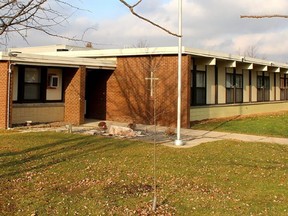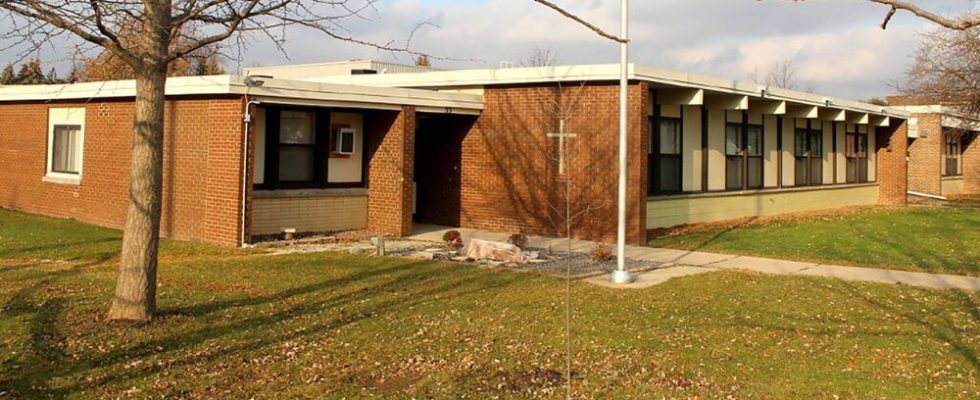
The number units in a proposed supportive housing project for a Chatham neighborhood will remain, but how it is developed could change.
Several residents attended Monday’s planning meeting to let Chatham-Kent council know about their concerns over plans by Indwell Community Homes, a Christian-based charitable organization, to build 95 supportive housing units on site of the former St. Agnes Catholic elementary school.
Residents told council they have safety worries if the units are filled with people who have addiction and mental health issues.
They also believe the proposed three-storey new build is too large for the single-acre site at 55 Croydon Street.
“I don’t believe this will be the quiet, safe community I bought into so many years ago,” Janet O’Hara told council.
“I would be happy if it was two storeys high,” neighborhood resident Sheila Martin told The Chatham Daily News.
She said the neighbors are not opposed to supportive housing in their neighborhood, and want to see the Indwell project be a success.
“But, we don’t think it should change the face of the neighborhood, it should blend into the neighborhood,” Martin said.
She agrees Chatham-Kent needs these supportive housing units, but questions why so many need to be built in their neighbourhood.
O’Hara said Indwell has indicated it wants to build 150 supportive housing units across Chatham-Kent, but the majority don’t need to be built in their neighbourhood.
The project was before council to vote on a zoning bylaw amendment to allow supportive housing as an additional use and to set the minimum off-street parking requirement at 0.5 spaces per unit.
After hearing concerns of residents, South Kent County. Ryan Doyle initially discussed making a motion to reduce the density under the institutional zoning on the property to 65 units.
However, the motion was changed after learning a $14 million application to the federal Rapid Housing Initiative (RHI) is based on a minimum of 71 units.
Chatham County. Michael Bondy stated his opposition to the size of the project, raising questions about how the water and wastewater infrastructure could handle this many new residents.
“I think this is a bad fit for the neighborhood,” he said. “The property values are clearly going to plummet.”
Council voted against the amendment to reduce the density to 71 units and voted in favor of the two recommendations regarding supportive housing and parking, which keeps the density at 95 units.
Graham Cubitt, projects and development director for Indwell, applauded council for making hard decisions with all the information they could possibly get.
He noted the RHI funding is for a 71-unit new build on the site. The other 24 units were planned to be part of revamping the school property.
Cubitt told council he believes there might be latitude within the RHI program to flex where the units are built that would allow the 24 units planned for the school renovation to be part of the first phase of construction.
However, he added that will require a lot of technical review before a final decision is made.
“The key piece, I will reiterate, it is very important council decided to remain committed to the Rapid Housing Initiative application, because that’s the most critical piece for bringing federal investment here to Chatham-Kent,” Cubitt said.
Keeping the 95-unit plan is “the best outcome for keeping as many community facilities within the existing building as possible,” he said.
Many people in the community have asked if they could use the gymnasium for karate classes, theater or community meetings, he added.
“Those are really key things that are missing every time we close a school,” Cubitt said.
He added they are lost to the community and never get replaced.
When asked if concerns being raised by local residents is common for proposed Indwell projects, Cubitt said, “Absolutely, because . . . we’re all neighbors that have had some negative experience with domestic violence, bike stealers or traffic. We’ve all experienced something we can’t control.”
He added the flipside is “Indwell is a long-term, committed neighbor that is open to feedback, open to criticism, open to correction.”
Cubitt said in past projects, dialogue with residents has been ongoing throughout the planning process, following the planning process and throughout construction, and post-occupancy.
“I’ll talk to my colleagues and we’ll look forward to setting up more dialogue with neighbors to specifically look at what of their concerns can we address through design changes, through layout, through safety plans, through intake, through all of those things.”

Comments
Postmedia is committed to maintaining a lively but civil forum for discussion and encourages all readers to share their views on our articles. Comments may take up to an hour for moderation before appearing on the site. We ask you to keep your comments relevant and respectful. We have enabled email notifications—you will now receive an email if you receive a reply to your comment, there is an update to a comment thread you follow or if a user you follow comments. Visit our Community Guidelines for more information and details on how to adjust your email settings.
Join the Conversation